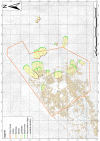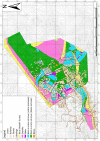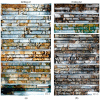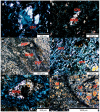Investigation of Critical Geotechnical, Petrological and Mineralogical Parameters for Landslides in Deeply Weathered Dunite Rock (Medellín, Colombia)
- PMID: 34769662
- PMCID: PMC8582660
- DOI: 10.3390/ijerph182111141
Investigation of Critical Geotechnical, Petrological and Mineralogical Parameters for Landslides in Deeply Weathered Dunite Rock (Medellín, Colombia)
Abstract
The current study site of the project Inform@Risk is located at a landslide prone area at the eastern slopes of the city of Medellín, Colombia, which are composed of the deeply weathered Medellín Dunite, an ultramafic Triassic rock. The dunite rock mass can be characterized by small-scale changes, which influence the landslide exposition to a major extent. Due to the main aim of the project, to establish a low-cost landslide early warning system (EWS) in this area, detailed field studies, drillings, laboratory and mineralogical tests were conducted. The results suggest that the dunite rock mass shows a high degree of serpentinization and is heavily weathered up to 50 m depth. The rock is permeated by pseudokarst, which was already found in other regions of this unit. Within the actual project, a hypothesis has for the first time been established, explaining the generation of the pseudokarst features caused by weathering and dissolution processes. These parameters result in a highly inhomogeneous rock mass and nearly no direct correlation of weathering with depth. In addition, the theory of a secondary, weathering serpentinization was established, explaining the solution weathering creating the pseudokarst structures. This contribution aims to emphasize the role of detailed geological data evaluation in the context of hazard analysis as an indispensable data basis for landslide early warning systems.
Keywords: block-in-matrix structure; dunite; geological investigation; landslide investigation; mineralogical predisposition; pseudokarst; secondary serpentinization.
Conflict of interest statement
The authors declare no conflict of interest.
Figures














References
-
- Thuro K., Singer J., Menschik B., Breuninger T., Gamperl M. Development of an early warning system for landslides in the tropical Andes (Medellín; Colombia) Geomech. Tunn. 2020;13:103–115. doi: 10.1002/geot.201900071. - DOI
-
- Botero G. Contribución al conocimiento de la geología de la zona central de Antioquia. Univ. Nac. Colomb. An. Fac. Minas. 1963;57:101.
-
- Álvarez A.J. Tectonitas dunitas de Medellín, departamento de Antioquia, Colombia (Informe1896) Ingeominas Intern. Rep. 1982;28:13–44.
-
- Restrepo J.J., Toussaint J.F. Unidades litológicas de los alrededores de Medellín; Proceedings of the Primera Conferencia Sobre Riesgos Geológicos del Valle de Aburrá; Medellín, Colombia. 3–6 December 1984; Bogotá, Colombia: Sociedad Colombiana de Geología; 1984. pp. 1–26.
-
- Agudelo J.Á. Tectonitas dunitas de Medellín, departamento de Antioquia, Colombia. Boletín Geológico. 1987;28:9–44.
Publication types
MeSH terms
LinkOut - more resources
Full Text Sources

